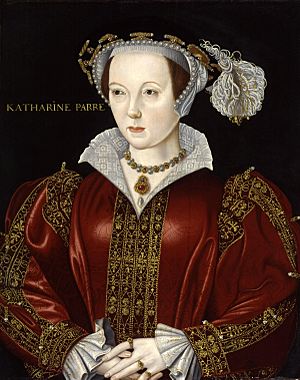Anne Bourchier, 7th Baroness Bourchier facts for kids
Quick facts for kids
Anne Bourchier
|
|
|---|---|
| suo jure Baroness Bourchier suo jure Lady Lovayne Baroness Parr of Kendal |
|
| Born | 1517 England |
| Died | 28 January 1571 (aged about 54) |
| Noble family | Bourchier (by birth) Parr (by marriage) |
| Spouse(s) | William Parr, 1st Marquess of Northampton |
| Issue | (illegitimate by John Lyngfield): Mary, wife of Thomas York |
| Father | Henry Bourchier, 2nd Earl of Essex, 6th Baron Bourchier, Viscount Bourchier, 2nd Count of Eu |
| Mother | Mary Say |
Anne Bourchier (born 1517, died 28 January 1571) was an important noblewoman in England. She held several titles in her own right, meaning she inherited them directly. These titles included the 7th Baroness Bourchier and Lady Lovayne. She was also known as Baroness Parr of Kendal through her marriage.
Anne was the first wife of William Parr, 1st Marquess of Northampton. He was a powerful nobleman. She was also the sister-in-law of Catherine Parr. Catherine was the sixth wife of Henry VIII of England.
In 1541, Anne caused a stir when she left her husband. She went to live with John Lyngfield. He was a church official. Anne and John had several children together. In 1543, her husband, Lord Parr, got a special law passed. This law ended their marriage and said it was never valid.
Anne's Family Background
Lady Anne Bourchier was born in 1517. She was the only child of Henry Bourchier, 2nd Earl of Essex. Her mother was Mary Say. Mary was a lady-in-waiting to Queen Catherine of Aragon. Catherine was King Henry VIII's first queen.
Anne's grandparents were Sir William Bourchier and Lady Anne Woodville. Lady Anne Woodville was the younger sister of Queen Elizabeth Woodville. Elizabeth was another English queen. This meant Anne was related to three of King Henry VIII's queens. These were Anne Boleyn, Jane Seymour, and Catherine Howard. They all shared the same great-grandmother, Elizabeth Cheney.
Because she was the only child of her father, Anne was one of the richest heiresses in England. An heiress is a female who inherits a lot of wealth. The Bourchier family's wealth came from a marriage in the 14th century. Sir William Bourchier married Eleanor de Lovayne. She was also a very rich heiress.
Anne had one son named John Parr. He was born around 1534.
Her Marriage and Titles
On 9 February 1527, Anne married Sir William Parr. He was the only son of Sir Thomas Parr. Anne was only about ten years old when she got married. Her mother-in-law carefully planned this marriage.


Anne inherited her titles on 13 March 1540. This happened after her father died in an accident. She became the 7th Baroness Bourchier and Lady Lovayne. However, her father's other titles, like Viscount Bourchier, did not pass to her. They ended when he died. Her husband, William Parr, had become the 1st Baron Parr of Kendal in 1539.
Anne's Later Life
When Queen Mary I came to the throne, William Parr was arrested. He had been involved in a plot against Queen Mary. This plot tried to put Lady Jane Grey on the throne instead. Parr was sent to the Tower of London. He was sentenced to death in August 1553.
Anne went to court to help her husband. She asked Queen Mary I to spare him. She hoped they could keep their family lands. William Parr was eventually released. The law that had ended their marriage was reversed in March 1554. This meant their marriage was now considered valid again.
Anne used this reversal to her advantage. She was given money each year, called an annuity. She received £100 in December 1554. In December 1556, she received another annuity of £450. She stayed at the royal court until Queen Elizabeth I became queen. William Parr was also given back his titles and honors.
Anne had more children with John Lyngfield. However, these children were not considered legal heirs. Only one daughter, Mary, lived to be an adult. Mary married a man named Thomas York. They had children, but they lived very ordinary lives. Some historians think Katherine Nott might have been another daughter of Anne. Katherine worked in Queen Elizabeth I's household for a short time.
Anne owned a property called Benington Park in Hertfordshire. Two men, Sir Robert Rochester and Sir Edward Waldegrave, held it for her. After Rochester died, Waldegrave gave the property to Sir John Butler. Anne sued Waldegrave and Butler in court. She won the case. Butler tried to fight it again, but he was not successful. After Queen Elizabeth I became queen in 1558, Anne moved to Benington Park. She lived there quietly for the rest of her life.
Anne's Death
Anne Bourchier died on 28 January 1571 at Benington. William Parr, her former husband, died in the same year. He was buried in the Collegiate Church of St. Mary in Warwick. The Queen paid for his funeral. William Parr had married two more times after Anne. But only his third marriage, to Helena Snakenborg, was considered legal. This was because he married her after Anne had died. He did not have any children with his wives. His remaining money and lands went to his cousins.
After Anne's death, her title of Baroness Bourchier passed to her cousin, Walter Devereux, 1st Earl of Essex.
Sources
- Martienssen, Anthony (1973). Queen Katherine Parr. New York: McGraw-Hill Book Company. ISBN: 0-07-040610-3
- www.thePeerage.com.

